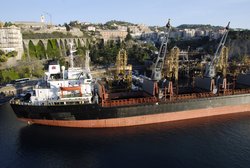Cargo ship
|
|
Cargo ship or freighter is any sort of ship that carries goods and materials from one port to another. Thousands of cargo carriers ply the world's seas and oceans each year; they handle the bulk of international trade. Cargo ships are usually specially designed for the task, being equipped with cranes and other mechanisms to load and unload, and come in all sizes.
Specialized types of cargo vessels include container ships and bulk carriers. (Technically tankers and supertankers are cargo ships, although they are habitually thought of as a separate category.)
The earliest records of waterborne activity mention the carriage of items for trade; the evidence of history and archaeology shows the practice to be widespread by the beginning of the 1st millennium BC. The desire to operate trade routes over longer distances and at more seasons of the year motivated improvements in ship design during the Middle Ages.
Before the middle of the 19th century, the incidence of piracy resulted in most cargo ships being armed, sometimes quite heavily, as in the case of the Manila galleons and East Indiamen.
Piracy is still quite common in some of the waters roughly around Asia, most notably in the Malacca Straits, a narrow channel between Indonesia and Singapore / Malaysia. In 2004, the governments of those three nations agreed to provide better protection for the ships passing through the Straits.
While the definitions have become "cross-pollinated" over the years, "cargo" technically refers to the goods carried aboard the ship for hire, while "freight" refers to the compensation the ship receives for carrying the cargo.
Larger cargo ships are generally operated by shipping lines, companies who specialize in the handling of cargo in general. Smaller vessels, such as coasters and tramp steamers, are often owned by their operators.
Famous cargo ships would include the liberty ships of World War 2 which were prefabricated all over the USA and then assembled by the coast in an average of 6 weeks and as little as 4 days. These allowed the allies to replace cargo vessels faster that the Kriegsmarine's U-boats could sink them and contributed significantly to the ability of the Allies to keep Britain in the war and build up men & equipment for the D-Day landings.

